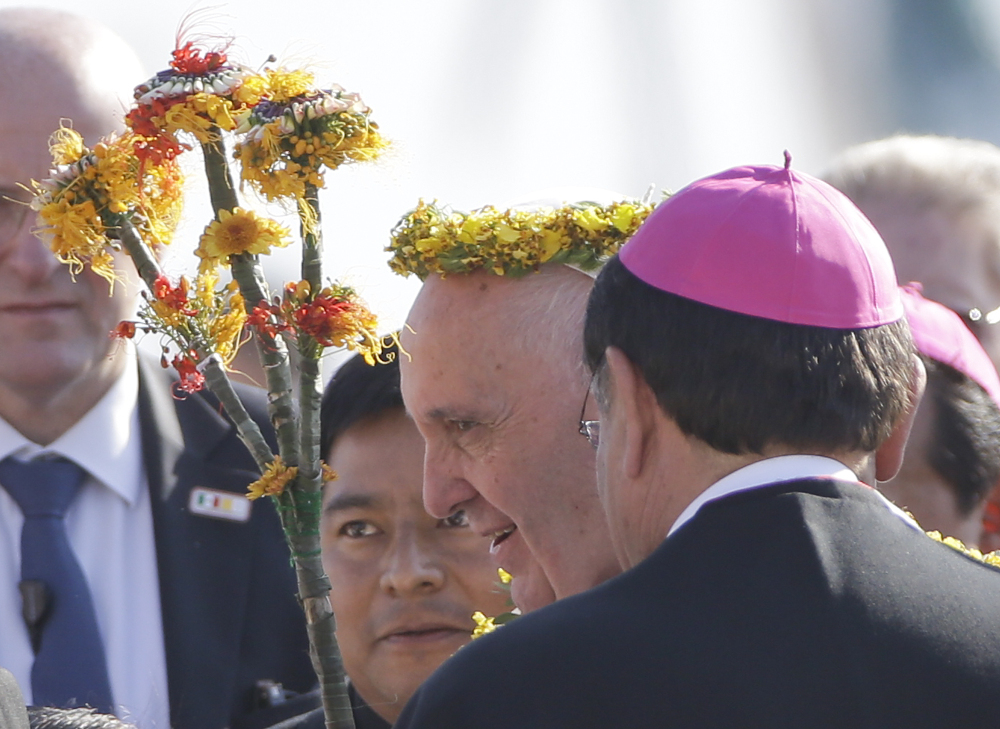SAN CRISTOBAL DE LAS CASAS, Mexico — Pope Francis denounced the centuries-old exploitation and social exclusion of Mexico’s Indians on Monday, saying the world should instead ask their forgiveness and learn from their culture and appreciation of nature.
Francis celebrated the Indians during a visit to the southern state of Chiapas, a center of indigenous culture. He presided over a Mass in three native languages in a service that also featured a traditional dance of prayer and a celebration of married deacons in Chiapas, whose role has been revived under his papacy.
In his homily, history’s first Latin American pope melded two of his core concerns: appreciation for indigenous cultures and the need to care for the environment.
“We can no longer remain silent before one of the greatest environmental crises in world history,” he told the crowd of several thousand indigenous people, some in traditional dress, who gathered at a sports complex in the mountain city of San Cristobal de las Casas.
“In this regard, you have much to teach us.”
The soft sounds of marimbas accompanied the Mass, which was celebrated in front of a replica of the brilliant yellow and red facade of the San Cristobal cathedral, where Francis visited later in the day.
Crowds chanted “Long live the pope of the poor!” and “Welcome, pope of the struggle!” as he arrived. Some 500,000 faithful were expected to see the pope in the city, including about 100,000 who gathered on the dirt field for the Mass.
Francis issued a sweeping apology last year for the Catholic Church’s colonial-era crimes against America’s indigenous. He revisited the issue again Monday, denouncing how, “in a systematic and organized way,” indigenous people have been misunderstood and excluded from society over the course of history.
“Some have considered your values, culture and traditions to be inferior,” he said. “Others, intoxicated by power, money and market trends, have stolen your lands or contaminated them.”
He called for a collective “Forgive me.”
“Today’s world, ravaged as it is by a throwaway culture, needs you!”
The pope has frequently expressed admiration for indigenous peoples, particularly their sense of being custodians of the environment. As archbishop in Argentina, he was heavily responsible for a major document of the entire Latin American church hierarchy in which bishops praised the harmonious way indigenous people live with nature. As pope, he penned an environmental encyclical denouncing the exploitation of the planet by the rich at the expense of the poor.
Indigenous communities have legal rights to much of Mexico’s forest and desert lands, and have long battled with outsiders to protect them – and to share in the revenues they produce. Mining and commercial logging interests that were granted concessions by national or state governments long denuded or polluted indigenous lands.
Francis’ visit to Chiapas and celebration of native culture is in many ways a swipe at the Mexican church hierarchy, which has long sought to downplay the local culture and bristled at the “Indian church,” a mixture of Catholicism and indigenous culture that includes pine boughs, eggs and references to “God the Father and Mother.”
It was a tradition that was embraced by the late bishop of San Cristobal de las Casas, Samuel Ruiz, who ran afoul of both the Mexican church and the Vatican at times for his support for indigenous culture. While Ruiz is still a controversial figure, Francis’ decision to come to San Cristobal, celebrate the Indians and use the local languages and customs in Mass was a strong sign that he was on Ruiz’s side.
Shortly after midnight, worshippers began filing into the site of the Mass, which included readings, prayers and hymns in the three main indigenous languages of Chiapas: Tzeltal, Tzotzil and Chol, which are spoken by just over 1 million people, according to Mexico’s latest census.
Send questions/comments to the editors.



Success. Please wait for the page to reload. If the page does not reload within 5 seconds, please refresh the page.
Enter your email and password to access comments.
Hi, to comment on stories you must . This profile is in addition to your subscription and website login.
Already have a commenting profile? .
Invalid username/password.
Please check your email to confirm and complete your registration.
Only subscribers are eligible to post comments. Please subscribe or login first for digital access. Here’s why.
Use the form below to reset your password. When you've submitted your account email, we will send an email with a reset code.